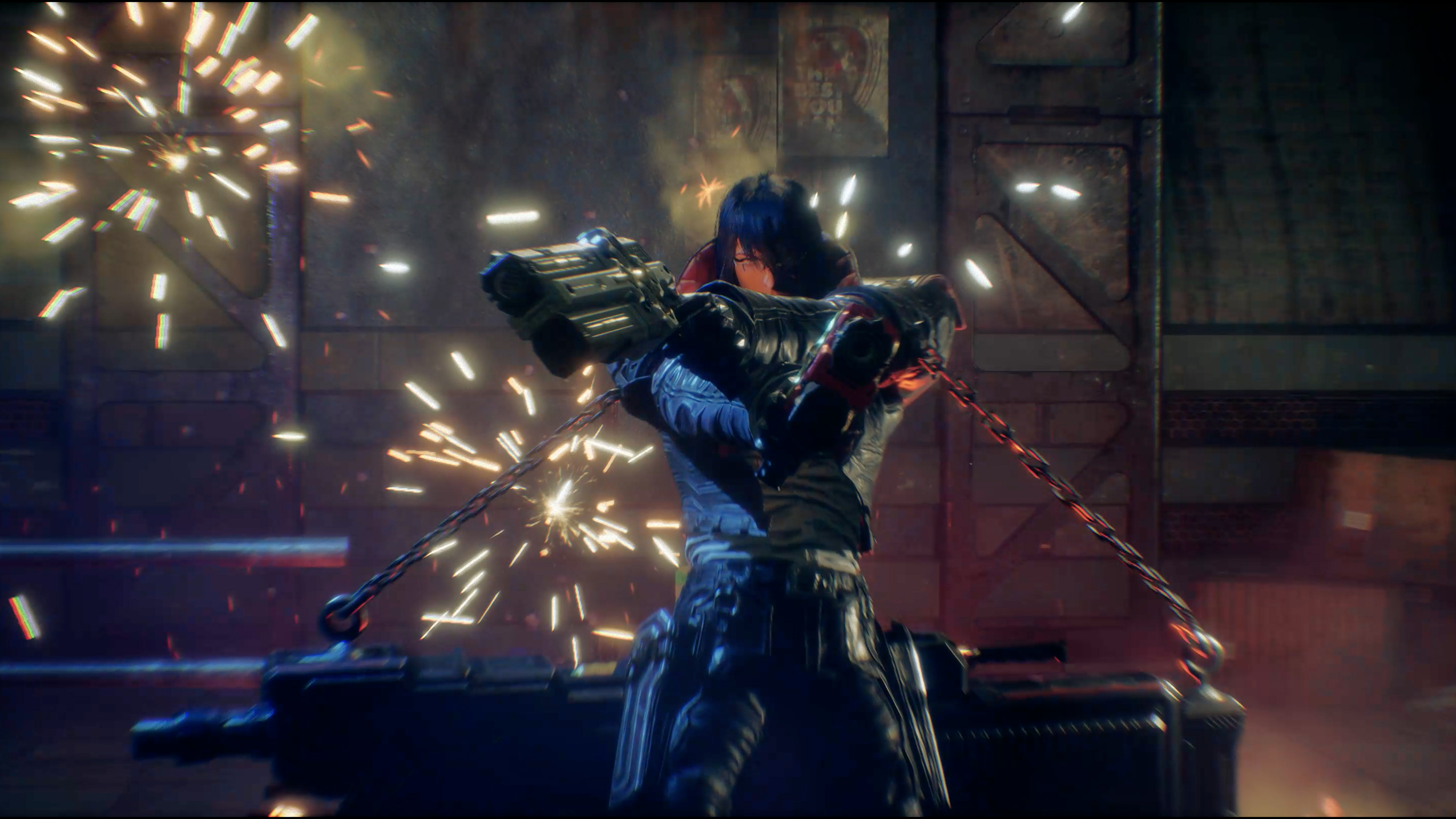I love campy, silly media as much as the next dork, and I can tolerate some jank in service of the bigger picture, especially when that jank is earned. I’m also a proponent of finding joy in otherwise-maligned bits of media, like most of the 3D Sonic games prior to Frontiers. Gungrave G.O.R.E, however, has sent my optimism reeling around this fictitious metric meant to find joy in everything.
It’s not just bad, it’s beyond the pale of what passes as acceptable in contemporary gaming.
The story seems to pick up immediately after the previous title and throws you in the deep end with enough acronyms to make any boardroom blush a little. It all amounts to a group of murderous goths, of which our titular Grave is a part, out to off a drug cartel — for reasons. And that’s about as much as you’ll get from it; following a brief intro sequence with some very stylized evisceration, it’s all cry havoc and let slip the goth of war.
At this point, I was pumped. I don’t need a narrative throughline to keep me hooked on a game that’s almost exclusively centered around bashing people’s heads in, though it is always welcome. Crushing skulls with my bare hands is enough. But the first few seconds of gameplay changed that; it’s enough to showcase what you’re in for throughout Gungrave G.O.R.E’s 10-or-so hour runtime — and it’s nothing like the cinematics you may have already seen.
The first thing that struck me is how slow it all is. Second is how hands-off the fighting is; roughly 90% of your time is spent pressing (not holding) the right trigger to fire Grave’s pistols while special moves charge up. Melee is nonviable because damage output is practically nil, and enemies don’t react to being struck by the full-size coffin that you’re carrying around at all times.
That is to say, the combat feels like it happens to enemies rather than with them. If you try to actually hit enemies as Grave does in all of the trailers, you’ll stand and trade blows, animating over each other like an early-internet MMO. And while the special moves are varied and necessary for upping your damage-dealing capability, some are lifted wholesale from earlier games, and they all take too long to unlock and upgrade.
The real trick to nailing a power fantasy action game is to have the player’s strength grow exponentially as they progress, but Gungrave is in a weird bind. It makes you feel like you can kill a thousand bros from the off and like you’re just kind of firing off a peashooter at cardboard cut-outs. The only real growth here will be in the muscles of your trigger finger, which will be verifiably swole if you see the whole game out.
So having established you’re in for a mechanical trudge in Gungrave, the rest of the game’s core components offer no solace either. Each of the game’s 31(!) stages plays out as a Hannah-Barbera-esque recycled corridor of the same enemies and non-descript locations. There’s barely a handful of enemy types in any level, and given the game’s focus on quantity, the pattern of “small guy in a white shirt, followed by a small guy in a black shirt, followed by a big guy” fans outward like a fractal.
The soundtrack, too, would be forgettable had you the chance to hear it, but it’s yet another thing that’s been overlooked and put on repeat ad nauseum. Gungrave’s opening chapters are particularly guilty of this, playing “time to kill, time to die” 20 times over the first five or so levels. It’s exhausting and only adds to the uncanny feeling of picking over 20-year-old scraps, which is the kindest examination of the game I can think of.
I had some performance issues in the pre-release build I played at first, including getting trapped behind doors wouldn’t open when scripted to, persistent or lacking audio, and enemies bugging out with the scenery or nearby objects. To Iggymob’s credit, the Day-One patch seems to have addressed all of these concerns. It’s just a shame they couldn’t have patched in some quality, too.
Gungrave G.O.R.E. Review — The Bottom Line
Pros
- Like all things, this too will end — eventually.
Cons
- Lifeless combat.
- Endless recycling of assets, most notably enemies and music.
- Just no fun at all, plain and simple.
I honestly wouldn’t be surprised if the bulk of Gungrave was developed in the mid-noughties, because despite the passably-AA-of-late-PS3-era graphics, it’s practically identical to its predecessors, both in terms of gameplay and level design. And to be kind to the earlier entries in the franchise, they were verging on unwieldy 20 years ago. Basically, nothing has changed between them, save a graphical overhaul.
To lean on the popular meme, Gungrave G.O.R.E. is like if you’re out shopping with your mum and pick up a copy of Devil May Cry. You ask for a combo-based, brainless action game starring a goth. “But we’ve got a combo-based brainless action game starring a goth at home,” she says, blissfully unaware of the gulf between what you want and what you got.
[Note: Iggymob provided the copy of Gungrave G.O.R.E. used for this review.]









Published: Dec 6, 2022 06:42 pm